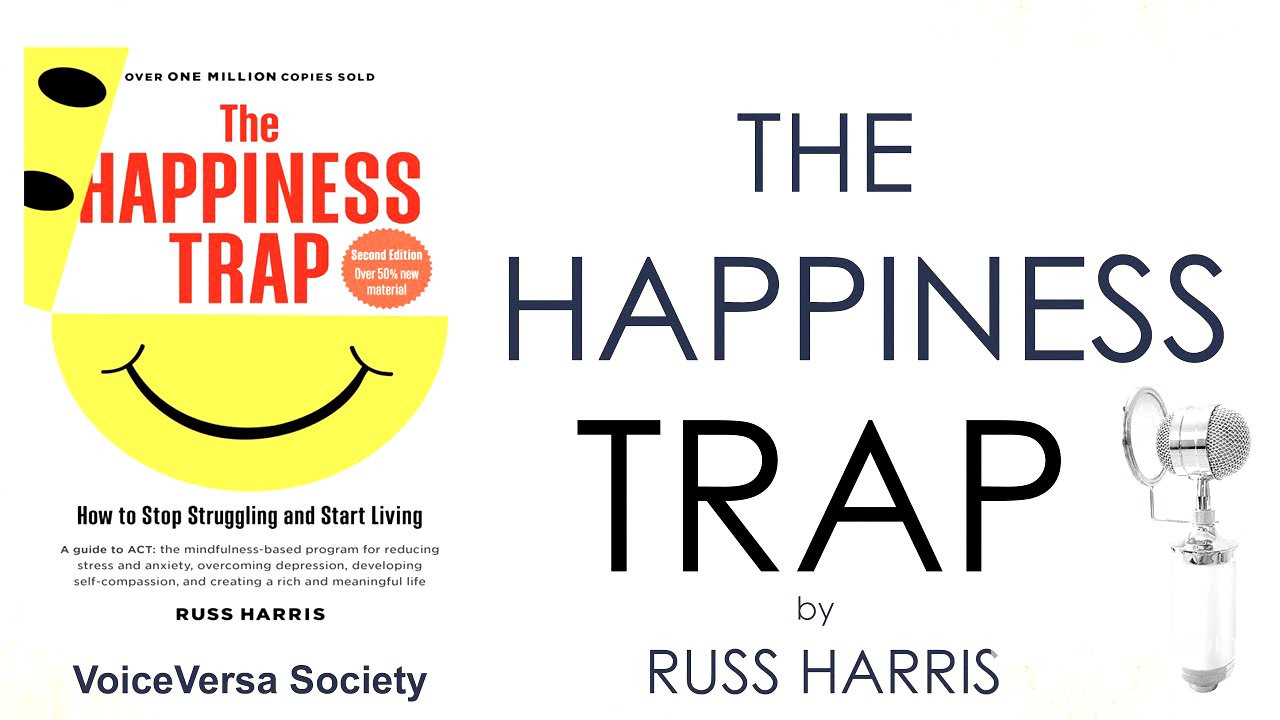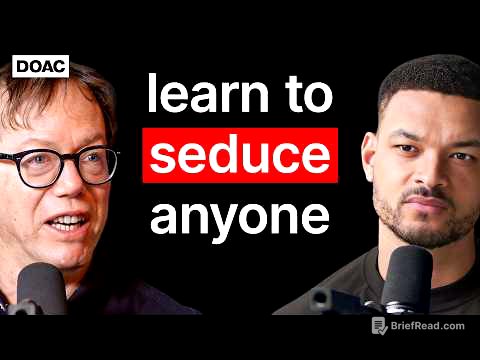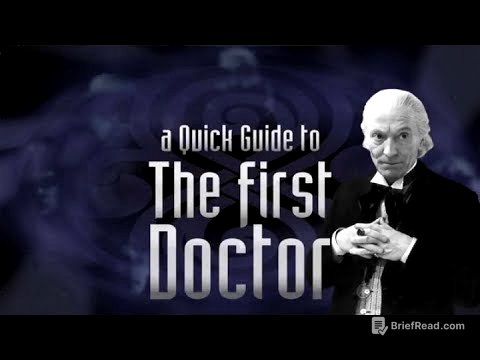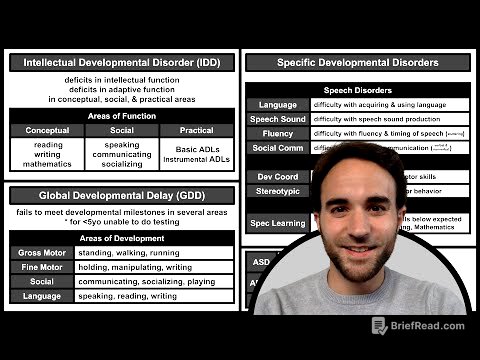TLDR;
This audiobook, "The Happiness Trap" by Russ Harris, explores the counterintuitive idea that the pursuit of happiness can often lead to unhappiness. It introduces Acceptance and Commitment Therapy (ACT) as a method to escape this trap by accepting painful thoughts and feelings, rather than struggling against them, and focusing on living a rich, full, and meaningful life guided by personal values.
- Challenges common myths about happiness.
- Introduces ACT principles: diffusion, expansion, connection, observing self, values, and committed action.
- Emphasizes acceptance of internal experiences and commitment to valued actions.
Dedication [0:29]
The book is dedicated to the author's parents for their love, support, inspiration, and encouragement, and to his wife Carmel for enriching his life with love, wisdom, and generosity.
Foreword [0:47]
The foreword discusses the irony of happiness, noting that the pursuit of happiness through control can lead to rigidity and unhappiness. True happiness is not just about feeling good but about living a rich and meaningful life. The book introduces Acceptance and Commitment Therapy (ACT) as a way to undermine struggle, avoidance, and loss of the present moment, helping individuals to live fully without waiting for life to begin.
I JUST WANT TO BE HAPPY [3:06]
The book questions common beliefs about happiness, suggesting they may be inaccurate and cause misery. It introduces Acceptance and Commitment Therapy (ACT), developed by Stephen Hayes, as a scientifically-backed approach to help individuals live a rich, full, and meaningful life while handling inevitable pain. ACT uses six principles to achieve this, differing from common-sense strategies in self-help books.
Is Happiness Normal? [5:56]
Despite a high standard of living in the Western world, human misery is prevalent. The increasing number of self-help resources and mental health professionals has not diminished human suffering, which is actually growing. Statistics show that a significant percentage of the population suffers from psychiatric disorders, addiction, and suicidal thoughts, indicating that happiness is not the norm.
Why Is It So Difficult To Be Happy? [8:58]
The difficulty in achieving happiness stems from the evolution of the human mind, which prioritized survival over feeling good. The mind is wired to constantly look out for danger, compare ourselves to others, and seek more, leading to dissatisfaction and psychological suffering.
What Exactly Is ‘Happiness’? [13:50]
Happiness has two meanings: a fleeting feeling of pleasure and a rich, full, meaningful life. The book focuses on the latter, which involves taking action on what truly matters, moving in valuable directions, and clarifying what we stand for. This leads to a profound sense of vitality, even with uncomfortable emotions like sadness, fear, and anger.
The Journey Ahead [17:06]
The book is structured into three parts: understanding the happiness trap, transforming your relationship with painful thoughts and feelings, and creating a rich and meaningful life. The journey requires time, exploration, and appreciation.
PART 1 How You Set The Happiness Trap. Chapter 1, FAIRYTALES. [17:38]
Fairy tales and Hollywood movies perpetuate the myth of "happily ever after," which sets unrealistic expectations for life. This is one of four major myths that contribute to the happiness trap.
Myth No.1: Happiness Is The Natural State For All Human Beings [18:27]
The belief that happiness is the natural state for all humans is disproven by statistics on suicide attempts, depression, and psychiatric disorders. Many people believe everyone else is happy except them, leading to further unhappiness.
Myth No.2: If You’re Not Happy, You’re Defective [19:32]
Western society views mental suffering as abnormal, leading to self-criticism and labels from health professionals that reinforce feelings of being defective. ACT proposes that psychological suffering is a natural result of normal thinking processes, not a sign of being defective.
The Illusion Of Control [24:40]
The human mind's ability to control the external environment leads to high expectations of control in other areas. However, thoughts, memories, and emotions are not easily controlled, and attempts to do so can be disappointing.
How We Learn About Control [28:45]
From a young age, individuals are taught to control their feelings through expressions like "Big Boys Don't Cry" and "snap out of it". This is reinforced in school and social interactions, creating the illusion that feelings can be turned on and off at will. The silence about true feelings and the false fronts people put on add to this illusion of control.
Chapter 2 VICIOUS CYCLES [33:15]
This chapter introduces the concept of vicious cycles, where attempts to solve problems actually worsen them. Control strategies, aimed at avoiding unpleasant thoughts and feelings, can lead to negative consequences and lower the quality of life.
What’s Your Problem? [33:45]
The chapter begins by prompting the reader to consider their own problems, such as relationship issues, job dissatisfaction, health concerns, or feelings of inadequacy. It suggests that attempts to escape or blot out the unpleasant thoughts and feelings associated with these problems may actually be lowering the quality of their life.
How Does A Solution Become A Problem? [34:50]
The chapter uses the analogy of scratching an itch to explain how a solution can become a problem. While scratching provides temporary relief, it can worsen skin conditions like eczema, creating a vicious cycle. Similarly, attempts to control unpleasant emotions can lead to negative consequences and perpetuate the problem.
The Problem With Control [38:27]
Using control methods to manage thoughts and feelings is not inherently problematic if done in moderation, in situations where they can work, and without preventing valued actions. However, control methods become problematic when used excessively, ineffectually, or when they hinder the pursuit of valued activities.
Using Control Excessively [39:33]
Excessive use of control strategies can have serious consequences, such as weight gain from emotional eating or addiction from relying on alcohol or drugs. These strategies, intended to avoid unpleasant feelings, can lead to further complications and more painful emotions.
Trying To Use Control In Situations Where It Can’t Work [41:52]
In situations where control is ineffective, such as dealing with grief, attempts to suppress or avoid painful feelings can be harmful. Grief, a natural emotional reaction to loss, cannot be avoided and must be accepted to pass in its own time.
When Using Control Stops Us From Doing What We Value [43:55]
Attempts to avoid unpleasant feelings can interfere with doing what we truly value, such as pursuing a career, maintaining health, or engaging in meaningful projects. Control strategies can damage physical health and prevent individuals from living a rich and fulfilling life.
How Much Control Do We Actually Have? [45:06]
The degree of control over thoughts and feelings depends on their intensity and the importance of what is being avoided. While control strategies may provide temporary relief, they can give a false sense of confidence and reinforce the illusion of control.
What Has Control Got To Do With The Happiness Trap? [46:57]
The happiness trap is built through ineffective control strategies, which take up time and energy, lead to feelings of inadequacy, and lower the quality of life. This creates a vicious cycle of experiential avoidance, a major cause of psychological problems.
How Do I Escape The Happiness Trap? [53:36]
Escaping the happiness trap involves increasing self-awareness, noticing attempts to control unpleasant thoughts and feelings, and recognizing the consequences. This awareness is the first step towards transforming the relationship with unwelcome thoughts and feelings.
PART 2,Transforming Your Inner World. Chapter 3 [54:43]
Acceptance and Commitment Therapy (ACT) is based on six core principles that help individuals handle painful thoughts and feelings and create a rich, full, and meaningful life. These principles include diffusion, expansion, connection, the observing self, values, and committed action.
Chapter 4, THE GREAT STORYTELLER. [59:11]
Humans rely heavily on words, which are symbols that stand for or refer to something else. Words are used in public (text, speech) and in private (thoughts). Thoughts are words inside our heads, distinct from mental pictures (images) and physical feelings (sensations).
Words And Thoughts [1:00:32]
Humans rely on thoughts to understand and navigate life, but thoughts are merely words. In ACT, thoughts are referred to as stories, which can be true (facts) or false, but are often opinions, attitudes, judgments, ideals, beliefs, theories, morals, plans, strategies, goals, wishes, and values. The focus is on whether a thought is helpful in creating the desired life.
The Story Is Not The Event [1:04:30]
A newspaper story about an event is not the event itself; it is just a story. Similarly, thoughts are not reality, but all too often, individuals react to their thoughts as if they are the absolute truth, a reaction known as cognitive fusion.
What Is Cognitive Fusion? [1:06:28]
Cognitive fusion is the blending of a thought and the thing it refers to, where the thought seems to be reality, the truth, important, an order, and wise. In this state, thoughts can also be perceived as threats.
‘I’M HAVING THE THOUGHT THAT...’ [1:08:21]
Inserting the phrase "I'm having the thought that..." before an upsetting thought creates distance from the thought itself, allowing one to step back and observe it. This technique, known as cognitive diffusion, helps individuals see thoughts as words passing through their head and nothing more.
MUSICAL THOUGHTS [1:11:40]
Singing a negative self-judgment to the tune of "Happy Birthday" or "Jingle Bells" diffuses the thought by realizing it is just made up of words, like the lyrics of a song. This technique helps individuals not take the thought quite so seriously.
The Mind Is A Great Storyteller [1:12:50]
The mind constantly tells stories, many of which are negative, feeding into anxiety, depression, and insecurity. ACT does not try to eliminate these stories but instead focuses on diffusion, acknowledging that they are just stories and not the absolute truth.
NAMING YOUR STORIES [1:15:47]
Identify the mind's favorite stories and give them names, such as "the loser story" or "the I can't do it story". When these stories show up, acknowledge them by name, which makes it less likely to get caught up in them.
Chapter 5, TRUE BLUES [1:18:48]
In ACT, whether a thought is true is less important than whether it is helpful. Thoughts are just stories, and if they are helpful, it is worth paying attention to them; if not, they should be diffused.
Chapter 6, TROUBLESHOOTING DEFUSION [1:37:40]
Diffusion is not a control strategy to get rid of anxiety but an acceptance technique. It helps to stop taking thoughts seriously, but it does not eliminate the feelings associated with them. The aim is to make peace with thoughts and allow them to be there without fighting them.
Chapter 7, LOOK WHO’S TALKING [1:52:49]
ACT teaches individuals to recognize two different parts of themselves: the thinking self (mind) and the observing self (awareness). The thinking self thinks, plans, and judges, while the observing self focuses on attention and awareness.
Realistic Expectations [2:06:28]
Diffusion skills are essential for escaping the happiness trap. By seeing thoughts for what they are and letting them come and go, individuals can focus their energy on more important things.
Chapter 8, SCARY PICTURES [2:07:36]
This chapter discusses how to handle frightening images that the mind conjures up. Techniques such as visualizing the image on a television screen, adding silly subtitles, or shifting locations can help to diffuse the image and lessen its impact.
Chapter 9, DEMONS ON THE BOAT [2:20:06]
This chapter uses the metaphor of demons on a boat to represent unpleasant thoughts, feelings, and urges. The key is to accept the presence of these demons and continue steering the ship towards shore, representing valued goals.
Chapter 10, HOW DO YOU FEEL? [2:27:54]
Emotions are physical changes in the body that prepare us to take action. While emotions influence our behavior, they do not control it. The chapter also discusses the fight-or-flight response and how it can be triggered in non-life-threatening situations.
Chapter 11, THE STRUGGLE SWITCH [2:43:58]
The struggle switch represents the choice to struggle against or accept difficult feelings. When the switch is on, individuals engage in a vicious cycle of trying to control their emotions, leading to more suffering. When the switch is off, they allow their emotions to be, freeing up energy for more meaningful activities.
Chapter 12, HOW THE STRUGGLE SWITCH DEVELOPED [2:50:56]
The struggle switch develops from childhood programming and societal messages about emotions. By judging emotions as good or bad, individuals set themselves up for a struggle with their feelings.
– Chapter 13 STARING DOWN DEMONS [3:03:52]
This chapter introduces the three steps of expansion: observe, breathe, and allow. By observing feelings, breathing into them, and allowing them to be, individuals can make room for unpleasant emotions and lessen their impact.
Chapter 14, TROUBLESHOOTING EXPANSION [3:20:34]
This chapter addresses common problems encountered when practicing expansion, such as using it as a control strategy or struggling with the process. It emphasizes that expansion is about acceptance, not getting rid of feelings.
Chapter 15 URGE SURFING [3:21:13]
This chapter introduces urge surfing, a technique for managing urges by observing them like waves, allowing them to rise and fall without acting on them. The observe acronym (observe, breathe, surf, expand, refocus, values, engage) provides a framework for this process.
Chapter 16, MORE DEMONS [3:37:42]
This chapter revisits the metaphor of demons on the boat, encouraging individuals to identify their own demons and practice diffusion and expansion techniques to lessen their influence.
Chapter 17, THE TIME MACHINE [3:40:58]
The thinking self is like a time machine, constantly pulling individuals into the future and the past, distracting them from the present moment. Connection involves living in the present, focusing on and engaging fully in whatever you're doing.
Chapter 18, THE DIRTY DOG [3:57:51]
This chapter emphasizes the importance of connecting with the present moment, even in unpleasant situations. By engaging the five senses and practicing mindfulness, individuals can transform mundane tasks into richer experiences.
Chapter 19, A CONFUSING WORD [4:08:33]
This chapter defines mindfulness as consciously bringing awareness to the present moment with openness, receptiveness, and interest. It distinguishes ACT from other mindfulness-based approaches, emphasizing that ACT is about taking action to improve life, not just about meditation or enlightenment.
Chapter 20, IF YOU’RE BREATHING, YOU’RE ALIVE [4:17:00]
This chapter emphasizes the importance of breathing as an anchor to the present moment. By focusing on the breath, individuals can increase self-awareness, accept their internal experience, and connect with their surroundings.
Chapter 21, TELL IT LIKE IT IS [4:32:07]
This chapter encourages the use of factual descriptions rather than judgmental ones to connect with the present moment. By providing a running commentary of what is taking place, individuals can stay grounded and avoid getting caught up in unhelpful thoughts.
Chapter 22, THE BIG STORY [4:38:03]
This chapter explores the concept of self-esteem, arguing that it is just an opinion and not a fact. It encourages individuals to let go of self-esteem and instead embrace self-acceptance, recognizing that they are not their thoughts and memories.
Chapter 23, YOU’RE NOT WHO YOU THINK YOU ARE [4:52:25]
This chapter introduces the concept of the observing self, a powerful aspect of human consciousness that has been largely ignored by Western psychology. The observing self is the part of you that is responsible for focus, attention, and awareness.
Qualities Of The Observing Self [4:55:32]
The observing self cannot be judged, cannot be hurt, is always there, and is perfect. It is the source of true acceptance and is not a thing made of physical matter.
The Observing Self In Everyday Life [4:58:25]
In everyday life, glimpses of the observing self are often obscured by a constant flow of thoughts. However, by tuning into the observing self, individuals can transform their relationship with unwanted thoughts and feelings.
PART 3,Creating A Life Worth Living [5:01:25]
This section transitions to creating a life worth living by clarifying values and taking committed action.
Values Versus Goals [5:05:55]
Values are ongoing directions, while goals are specific outcomes. Living by values provides a sense of vitality and joyfulness, making life rich and meaningful even when bad things happen.
Imagine You’re 80 Years Old [5:10:46]
This section prompts the reader to imagine themselves at 80 years old, reflecting on their life and identifying any regrets or missed opportunities.
Chapter 25, THE BIG QUESTION [5:11:55]
This chapter encourages deep reflection on what is truly important in life, what one wants their life to be about, and what sort of person they want to be.
Time To Reflect [5:16:46]
The chapter emphasizes the importance of reflecting on the questions posed and identifying the values that are most important and most neglected.
Chapter 26, TROUBLESHOOTING VALUES [5:18:08]
This chapter addresses common challenges encountered when clarifying values, such as doubting their authenticity or feeling overwhelmed. It provides questions and techniques to overcome these obstacles.
THE ‘THIS IS SO CORNY’ DEMON [5:21:27]
This section addresses the demon that judges values as corny or cliched, encouraging individuals to acknowledge the judgment and carry on with clarifying what is important to them.
Chapter 27, THE THOUSAND-MILE JOURNEY [5:23:40]
This chapter outlines the steps for setting meaningful goals: summarize values, set an immediate goal, set short-term goals, set medium-range goals, and set long-term goals. It also emphasizes the importance of setting "live person's goals" rather than "dead person's goals".
Step 3: Set Some Short-term Goals [5:26:53]
This section emphasizes the importance of setting short-term goals that are consistent with values, providing direction and motivation.
Imagine Yourself Taking Effective Action [5:29:52]
This section encourages the use of visualization to imagine oneself taking effective action, focusing on actions rather than feelings.
Action Plans [5:34:15]
This section emphasizes the importance of breaking down goals into an action plan, identifying the smaller steps required, the resources needed, and the specific timing for each action.
Chapter 28, FINDING FULFILMENT [5:38:27]
This chapter contrasts a goal-focused life with a values-focused life, arguing that the latter is more fulfilling because it allows individuals to appreciate the journey, not just the destination.
Chapter 29, A LIFE OF PLENTY [5:47:03]
This chapter encourages individuals to appreciate the abundance in their lives by practicing mindfulness and connecting with their senses. It also emphasizes the importance of sharing positive experiences with others.
It’s All About Connection [5:54:24]
The more individuals open their eyes and notice the things they have taken for granted, and the more they live by what they value, the richer, fuller, and more meaningful their life becomes.
Chapter 30, FACING FEAR [5:56:46]
This chapter addresses the four major obstacles to change: fusion with unhelpful thoughts, expectations that are unrealistic, avoidance of uncomfortable feelings, and remoteness from values. It provides solutions for overcoming these obstacles.
How Do You Tell An Excuse From A Fact? [6:06:05]
This section provides guidance on distinguishing between valid reasons and mere excuses for inaction, emphasizing the importance of honesty and self-awareness.
Chapter 31, WILLINGNESS [6:09:57]
This chapter introduces willingness as a key component of commitment, emphasizing that it involves accepting discomfort in order to pursue valued goals.
Willingness Has No Shades of Grey [6:17:21]
Willingness is an all-or-nothing experience, not a matter of tolerance or resignation. It involves fully embracing life, even with its difficulties.
Chapter 32, ONWARD AND UPWARD [6:24:45]
This chapter emphasizes the importance of continuing the journey, even when stumbling or getting off track. It encourages individuals to learn from their mistakes and keep moving in a valued direction.
Making Mistakes [6:29:07]
Making mistakes is an essential part of the learning process. Commitment means taking effective action, allowing oneself the freedom to make mistakes, accepting oneself compassionately when screwing up, and carrying on moving in a valued direction.
Redefining Success [6:32:53]
Success in life means living by your values. This definition allows individuals to be successful right now, regardless of whether they have achieved their major goals.
Try, Try Again? [6:36:55]
Persistence is important, but it is also essential to pay careful attention to what is being done in order to assess whether it is effective. If something is not working, it may be necessary to try something different.
– Opportunity [6:41:41]
Opportunity is often missed because it is dressed in overalls and looks like work. By embracing the opportunity in difficulty, individuals can make their lives far richer and more meaningful.
Choose To Grow [6:44:28]
In every painful life circumstance, there is an opportunity to grow. By embracing this opportunity, individuals can transform their lives and find meaning even in the midst of suffering.
Feeling Stuck? [6:47:24]
If feeling stuck, it is important to identify what is getting in the way and take steps to resolve it, such as practicing diffusion, setting realistic expectations, developing willingness, and connecting with values.
Focus On What’s In Your Control [6:50:23]
It is important to focus on what is in your control: your actions and your attention. By focusing on these two things, you can create a rich and meaningful life.
Acknowledgments [6:54:08]
The author expresses gratitude to Stephen Hayes, the ACT community, colleagues, family, editors, and others who contributed to the book.









